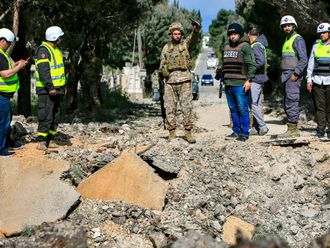Manama: Details about wind and wave conditions around the coast of Qatar have been recorded in a study funded by Qatar National Research Fund (QNRF).
To build the case for wind and wave studies, a research team at Texas A&M University at Qatar (TAMU-Q) positioned the most sophisticated equipment available on the edge of a 500-metre pier extending into the Gulf.
Their findings highlighted the need for a permanent monitoring station in Qatar, with the potential to offer vital insights into many industry sectors, QNRF said in a statement.
“The actual research started in trying to understand the relationship between the wind and waves,” said Dr Reza Sadr, Assistant Professor in the Mechanical Engineering Department at TAMU-Q. “Why do we need to understand the relationship between wind and waves? Because there are very poor models to track wind current and predict ocean waves, and this information affects, among other things, marine life, the offshore oil and gas industry and renewable energy initiatives.”
Sadr said that the existing methods for measuring the patterns of wind and waves needed to be fortified with more sophisticated data and analysis for each region of the globe.
“The US navy is studying this, as are oil companies, but the data available is not high quality,” he said. “One thing that we know so far, however, is that the patterns around the world are different. The North Sea is different from the Atlantic Ocean, which is different from the Gulf of Mexico. Even within the Atlantic Ocean there are differences, from, say, Cuba and then up toward New York City and Boston. Knowing this, we understand how critical it is to characterise the conditions for each place, specifically.”
The study was supported by a grant under QNRF’s National Priorities Research Program (NPRP) and was the first of its kind to be conducted in the region.
The researchers collected data continuously for six months, from June to November, in Qatar and used devices that relied on sonic waves to measure atmospheric wind at high frequency and in several dimensions, allowing them to study fluctuations in wind movement in the midst of high temperatures and humidity.
Previously, weather information in Qatar largely came from satellites, which provided basic information but lacked the detail captured by deeper studies such as this one, the statement said.
The collation of comprehensive data on wind, and its impact on waves, would contribute greatly to the oil and gas industry as it increasingly moves offshore, Sadr said. The information would additionally serve the aviation industry as Qatar positions itself as a regional aviation hub, with its massive new international airport scheduled to open in the near future. As the nation looks seriously into renewable wind energy, the applications become particularly important in studying turbulence, which must be specifically modelled for each location and system.
The hazards and pollution related to the region’s ubiquitous oil and gas industry also create a critical need for location-specific, high-quality data in Qatar. More detailed knowledge of Qatar’s atmospheric conditions would help determine how pollution and burning gases are dispersed in the environment and, in the event that an accident occurs, help calculate how long pollutants would remain at harmful levels for humans.
The team from TAMU-Q has published part of its findings on the wind and wave conditions surrounding Qatar and is now moving on to study coastal conditions, including the relationship between land and sea. They will pay particular attention to reclaimed coastline projects, and their effect on the natural coastline and marine life.
The team hopes that the QNRF-funded research will provide the impetus for a permanent wind and wave monitoring station in Qatar.











